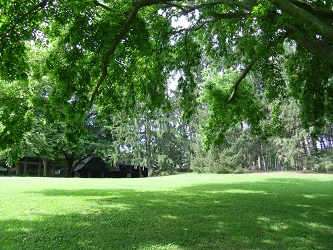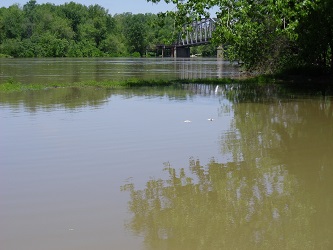Summer Newsletter Ideas for Your Neighborhood's Editor
Last Updated: May 21, 2022
This page gives some summer newsletter ideas for community organizations, as part of our series of thought starters for each season of the year. Some of you have long since abandoned newsletters, whether electronic or paper, in favor of social media. The suggestions below may be equally helpful as you stare at a blank box trying to think of something fresh to post.

In most cultures summer is seen as a season of vacations and holidays, well-deserved laziness for those not contributing to the agricultural sector of society, long days of work for agriculture, abundant production of vegetation, lots of time spent outdoors, and breaks from routines. You can take advantage of these memes to do something unexpected and playful as you search for summer newsletter ideas. If your editor needs a rest, this is the time to take it, either by reducing content slightly or by skipping an issue or a mailing.
Favorite Summer Newsletter Ideas
1. Write detailed and enthusiastic copy and post great photos building momentum for upcoming summer and fall festivals or parties. If you have an annual event, find plenty of good photos from past years to include, and overload your electronic newsletter with them. Also it's fine to post photos from last year on your social media to raise the excitement level about the upcoming event. If this is a first-time event for you, try to give a sneak preview.
For instance, if you will have a barbecue, snap a photo of the grill master at work, or of his or her equipment. If you plan a street festival, see if you can stage a photo of someone building the stage, calling to line up the talent, putting up the flyers (or the No Parking signs if your newsletter takes shape a day or two before the event). Be sure to explain and promote all the activities that will be available, explain the schedule, address parking and logistics, and talk about how the event will interest different audiences, from children to teens to young families to seniors. Of course if you have last minute needs for supplies, equipment, or volunteer help, don't be shy about asking.
In formats where there is room, be sure to explain how the idea for the event was born, and how you hope it will be significant for the neighborhood. Profile event leaders and financial contributors.
Incidentally, after the event please send us some photos and a write-up about what you did on our street parties page. After approval, what you send then becomes a permanent and free-standing web page available to all our site visitors. One group let us know that they used that they used that page to support a successful application for a local award.
2. Children may be out of school more in the summer than at other times of the year. If this is true where you live, invest a little effort in asking teachers, coaches, art teachers, and talented parents to give you some ideas for fun and educational activities for children.
Also you could try to plan a children's activity for your neighborhood association, which then could be explained and promoted through your newsletter. Ideas could be a nature walk or an architectural walk, followed by local ice cream. You also might have the kids hang out with one of your first-rate activists while they lead a clean-up activity or help out at the library or the dog park.
A games day in the local park is a natural. In addition to competition in sports now popular with the children, find some non-competitive or old-fashioned games that the kids probably have never encountered.
You could organize a field trip for the kids, taking them to see the inside of a local landmark that is not typically open to them or to a business or industry in the neighborhood. Tour plants where there is plenty of outdoor space or ventilation. Use your imagination to make an exciting day, of course topped with refreshments and play time in the park.
Talk with your local police department to agree on an activity where children meet the police in an informal setting, and hopefully meet them more than once. The aim will be to increase trust in police.
These children's activities will provide plenty of summer newsletter ideas, both as you promote the activity in advance and then afterward as you report on it for the benefit of the folks who don't have kids.
3. Especially in "four seasons" types of climates, often crime rates increase in the summer. Ask your local police department to give you some tips on crime prevention or reporting. You also can describe the measures police recommend for leaving home to go on vacation. If you live in a community where a university has a criminology department, you might interview a criminologist for his or her take on your local issues.
This is also a good time to plug any announcements from neighborhood watch groups or block units about their activities. If crime is an issue at all, you may want to talk with your police department about forming neighborhood watch units if you don't have them.
Even without a formal court monitoring program, you might want to report any recent court activity that would reinforce other messages about crime prevention that you want to emphasize.
Concentrate on a particular type of crime that is common or prevalent in your community, and then develop some summer newsletter ideas to help move the dial in the right direction on that issue.
4. We hope you took up our suggestion on the spring newsletter ideas to begin planning a parklet for what is called PARK(ing) Day, internationally set for a date in September. If you did, now is the time to report on the site you selected, the schedule for when the temporary pop-up installation will be open, and as many of the plans as you know. Remember to credit any landscape architects, parks professionals, traffic engineers, and other city professionals or consultants who are helping you. If you know of merchants who are donating items, such as potted plants, give them credit now, even if you realize your list is incomplete. It's just fine to have the early movers among the businesses get a little extra recognition.
If you're participating in this activity, it is a good time to remind folks that building owners can seek pop-up businesses on the same principle--that trying out a space may result in a permanent change for the better.
5. Some of the best summer newsletter ideas we have seen draw upon the increase in walking and biking in the summer, due both to weather and to vacation schedules. Grab hold of this idea to discuss barriers to walking or biking in your neighborhood and to highlight lesser known trails or walking routes. In fact, invent some interesting walking routes through your neighborhood, and use those in your newsletter. Again, you can use an interviewing technique to ask your local traffic specialists what can done to improve walkability or bikeability. By the way, if this person thinks the premise of the question is stupid, it's time to use your newsletter to rev up support for these active transportation methods.
Your article could talk about the amount of air pollution that cars dump into the atmosphere, the cost of driving a car, and the ways in which parking takes up space that could be used in a livelier way.
If there are neighborhood traffic issues that have been bothering people, think of some summer newsletter ideas that will report statistics, tout proposed solutions or report what experts and city officials have been saying about your particular problem. If better driver behavior is necessary, use your newsletter platform to explain the importance of the issue to others and to appeal for help.
6. Our sixth category of summer newsletter ideas will seem very familiar to readers of this website. So we will be brief, but we will tell you that a cleanup activity is nearly perfect in terms of being able to see results quickly, requiring only a short burst of activity from volunteers, being social media friendly, and being repeatable with an ever-decreasing amount of organizational effort.
So just organize a cleanup morning for your watershed, neighborhood park, alleys, streams, or really awful vacant lots.
7. Remember summer status updates on private construction projects, public works and utilities projects (and detours), street resurfacing, school construction and remodeling, and stores and restaurants that are coming, going, or changing concept.
8. Because it is home remodeling and re-roofing season also, it's a good time to brief homeowners on when building permits are required, and how to obtain them. Do new swimming pools and fences require a permit? How about permitting when you are replacing those items? What about replacing a bathroom? How about building a closet? If a homeowner is doing the work himself or herself, how is that different from when you have a contractor?
Since many contractors will pull the permits for your project, another thing to point out to your readers is whether there are any contractor licensing requirements in your area.
And with or without licensing, where should a resident report being ripped off by a contractor, or being the victim of shoddy work? You could explain the importance of bids, lien releases, and written contracts too.
9. Summer may be the time when you can get by with a little bit more light-hearted fare than normal. If your neighborhood association actually is pretty quiet during the summer, then you might want to opt for ice cream and gelato recipes, summer grilling tips, or book reviews for light summer reading. If you have a library or book store in your neighborhood, you can probably entice them to do the actual writing.
Maybe you can find summer newsletter ideas among the trees and plants that are in full glory during this season. Ask a biologist, naturalist, or gardener for some suggestions about species that are especially desirable or undesirable locally.
10. Enlist high school age students to interview people who have participated in neighborhood history and write a story about their experiences. Or they may want to collect oral history recordings and then write brief synopses of those interviews for your newsletter.
11. Remember to highlight any upcoming local elections, hearings, or public meetings just as you would do in other months.
Finally we want to make sure you know that we have a general article on the homeowner newsletter, which offers an overview of the why and the how of newsletters. Once you have made those basic decisions, it's time to try some of the summer newsletter ideas just above, or to take a walk around the neighborhood looking for interesting subjects that are particular to your environment.
- Making and Keeping a Good Community ›
- Community Organizations ›
- HOA or Neighborhood Newsletter › Summer Newsletter Ideas
Join GOOD COMMUNITY PLUS, which provides you monthly with short features or tips about timely topics for neighborhoods, towns and cities, community organizations, and rural or small town environments. Unsubscribe any time. Give it a try.
